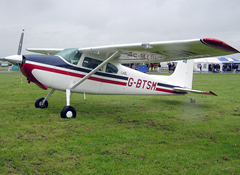 Flying an aircraft with a tailwheel will feel a little different from flying an aircraft without one and there are some important tips to keep in mind in order to stay safe. Hence and for any pilot who is thinking of flying an aircraft with a tailwheel, Brian (the pilot/blogger behind Brian’s Flying Blog) has recently posted an extensive entry about obtaining a tailwheel endorsement and the differences between flying an aircraft with or without one.
Flying an aircraft with a tailwheel will feel a little different from flying an aircraft without one and there are some important tips to keep in mind in order to stay safe. Hence and for any pilot who is thinking of flying an aircraft with a tailwheel, Brian (the pilot/blogger behind Brian’s Flying Blog) has recently posted an extensive entry about obtaining a tailwheel endorsement and the differences between flying an aircraft with or without one.
Brian begins his post by pointing out that the tailwheel is negatively stable when its on the ground. Thus, when a pilot tries to slow down an aircraft with a tailwheel, the plane will want to flip around because the center of gravity is behind the main wheels. In addition, pilots will also notice that the controls feel a little different due to the distance between the main wheels and the steerable tailwheel. Hence, response time will be delayed and pilots must be careful not to change the steering to much after its already to late.
Brian then proceeds to go into some detail and provides useful tips about taxi operations, takeoffs, 3-point landings and wheel landings for pilots who are flying an aircraft with a tailwheel plus he lists several books and websites with further information. Hence, Brian’s post is well worth reading by any pilot who might consider flying an aircraft with a tailwheel.
Thus, when a pilot tries to slow down an aircraft with a tailwheel, the plane will want to flip around because the center of gravity is behind the main wheels.
You've just put me off the idea. 😀
Try aircraftdifferencestraining James specialises in teaching tail wheel conversions.
Got two tailwheel airplanes I'm planning on flying when I get the chance. It will be by first time in a conventional gear airplane. Can't wait to see the difference after all these years of trike-ing it.